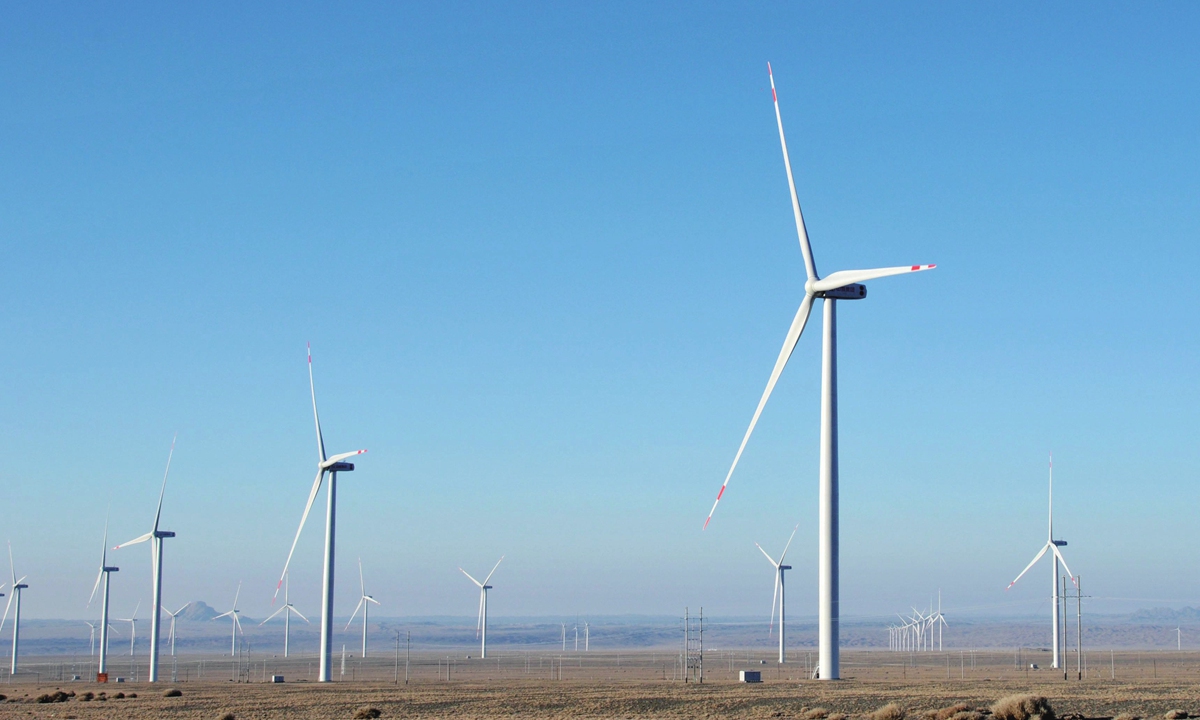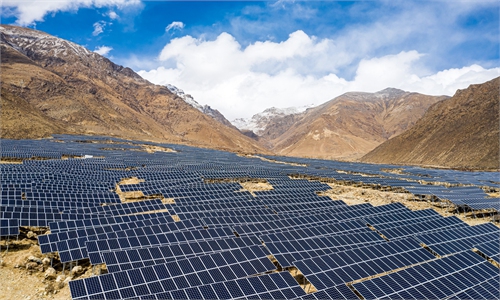
Wind turbines Photo: VCG
China's central government has advanced the development of a new energy system through accelerating decarbonization and pollution mitigation to realize an "ecological transformation" in the coming years to sustain China's green growth and at the same time to lead the global combat against climate change.
Increasingly, more people are reaching the consensus that only "clear waters and lush mountains are the silver and gold," which is becoming a major guiding philosophy embraced by China. Only harmonious co-existence of human and nature is sustainable over the long term, and it ought to be a mission embedded in the nation's overall development plan.
In contrast to the US government's retreating commitment to the industry under former president Donald Trump and the lip service paid by incumbent President Joe Biden, China has the political courage, economic incentive, technological capability and moral consensus to lead the global renewable energy drive and the fight against climate change.
The international community could be assured that China is genuinely interested in leading the world in deployment and investment in renewable energy. Over the last decade, the country has led the world in expanding the penetration and use of renewable energy. For instance, China owns five of the world's six largest solar-module manufacturing companies as well as the world's largest wind turbine manufacturer.
After a decade of intensive government-led efforts to curb air pollution and facilitate the Chinese economy's shift from fossil fuels to clean energy, a rising number of Chinese cities, including Beijing, Guangzhou, Shenzhen and other megacities, have met the national air quality standard. In Beijing, the yearly average level of fine particulate matter, or PM2.5, fell to 29 micrograms per cubic meter in 2021 - below the nationally set standard of 35 micrograms/cubic meters and less than half of that a decade ago. As a result, Beijing residents were enjoying four more months of blue skies last year than 2013.
That many other parts of China have also witnessed such remarkable improvement in air quality over the last 10 years shows China's sustained efforts to transition its energy structure to clean energy and pursue higher-quality economic development are increasingly bearing fruit.
Based on the country's energy and resource availability, China has been proactively promoting peak carbon in approximately 2030 and carbon neutrality by 2060. Renewable energy deployment is a prime part of a larger government effort to develop an "ecological civilization," which will be bolstered by a cross-industrial approach to lower pollution level and lower fossil fuel use, in addition to improving energy efficiency.
By 2030, at least one-fifth of China's electricity consumption will come from non-fossil fuel sources, according to a plan outlined by the central government. Currently, the share of non-fossil energy - wind, solar, hydropower, biomass and nuclear power - in primary energy consumption has risen from 9.7 percent in 2012 to 16.6 percent in 2021, while the share of wind and solar power in the country's energy mix having increased from 2.1 percent in 2012 to 11.7 percent at the end of 2021.
In the past years, the nation has scaled up its renewable energy production, solar, wind and nuclear power in particular, to replace the use of coal and oil, creating millions of jobs in the process.
Starting with the promulgation of the Renewable Energy Law in 2005, which institutionalized the policies to support renewable energy development, China has taken a raft of measures to facilitate the transition to renewable clean energy. The Ministry of Commerce's 2017 Industry Catalogue Guiding Foreign Investment lists renewable energy as an encouraged area for inbound investment, allowing foreign investors to establish wholly-foreign owned enterprises in the country.
And the central government's Air Pollution Prevention and Control Action Plan of 2013 vowed to reduce the share of coal in the country's energy mix to less than 65 percent by 2018, while drastically cut the use of coal in provinces and regions with high levels of air pollution. The Action Plan also strengthened pollution control and improved law enforcement in key polluting industrial lines such as electricity generation, heavy industry and auto manufacturing. As a result, many local governments have ramped up efforts, requiring enterprises to close down highly polluting operations and strictly implement pollution control standards.
Simultaneously, in China's vast northern rural areas, the government launched a program to replace coal with natural gas and electricity for winter home heating. Some provinces and regions have encouraged rural households to install solar photovoltaic panels as a part of the poverty alleviation initiative.
As a result of these efforts, China's solar and wind power industries have become the largest in the world and the country's energy structure has begun shifting toward renewable clean energy. For example, the share of coal in primary energy consumption fell from 68.5 percent in 2012 to 56.1 percent in 2021, and coal is likely to make up less than half of the total energy consumption by 2026.
As a renewable energy deployment continues to rise around the globe, the alignment of the country's capabilities and government incentives to invest in the sector positions China in an even stronger leading position for the green energy sector's future.
Analysis has cited China as the largest investor in low-carbon technology innovations - inputting a total of $260 billion in 2021 mainly in renewable energies and electric vehicles. Consequentially, China is leading the world in both new energy and electric vehicle development and production, which significantly adds to China's industrial competitiveness in the world, while creating up to 3 million high-paying jobs in the country.
As China has become one of the world's foremost developers of renewable technology and clean energy, the strategic benefits of investing in China and cooperating with Chinese scientists and technicians in research and development outstrips the odds. China's decade-long experience of transitioning to clean energy shows that doing so can benefit economic growth, improve people's livelihood and better protect the environment.
The author is an editor with the Global Times. bizopinion@globaltimes.com.cn



